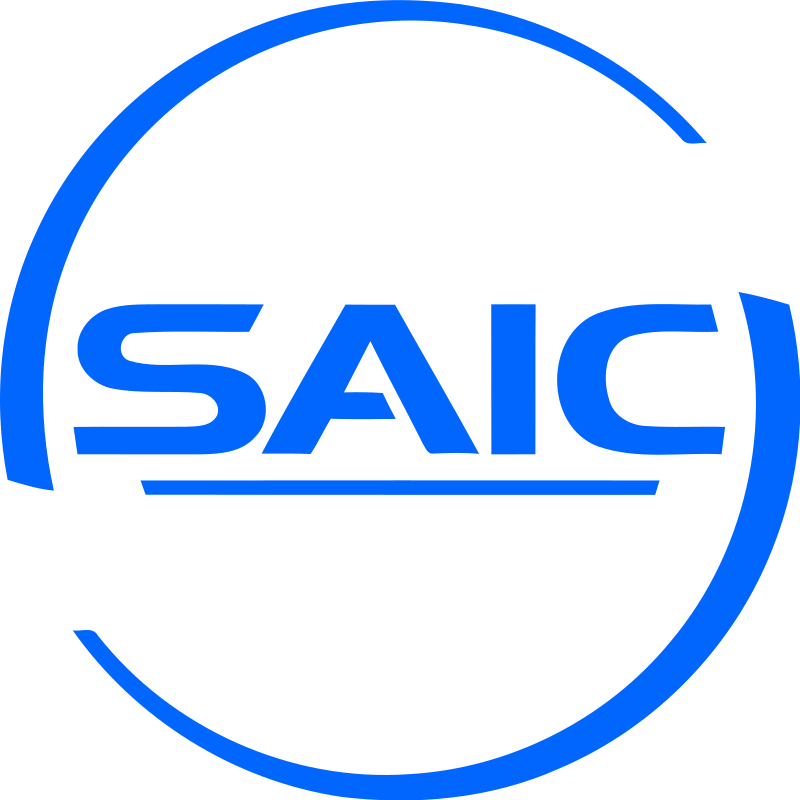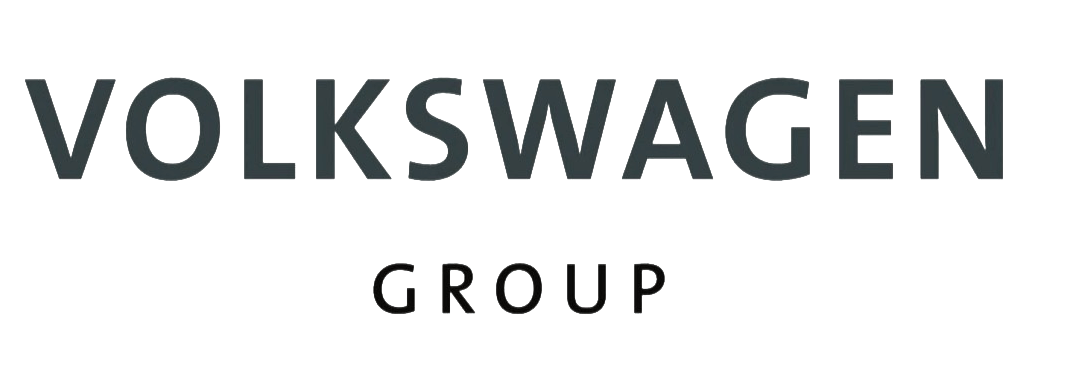Global Advanced Driver Assistance Systems (ADAS) Sensors Market: By Sensor Type, By Application, By Vehicle Type, By Region & Segmental Insights Trends and Forecast, 2024 – 2034
- Industry: Automotive & Transportation
- Report ID: TNR-110-1278
- Number of Pages: 420
- Table/Charts : Yes
- August, 2024
- Base Year : 2024
- No. of Companies : 10+
- No. of Countries : 29
- Views : 10058
- Covid Impact Covered: Yes
- War Impact Covered: Yes
- Formats : PDF, Excel, PPT
Advanced driver assistance systems (ADAS) sensors are specialized components integrated into vehicles to enhance safety, improve driving efficiency, and reduce the risk of accidents. These sensors work in conjunction with various systems to monitor the vehicle’s surroundings, detect potential hazards, and provide real-time data that assists the driver in making informed decisions. ADAS sensors are critical for functions such as lane departure warnings, automatic emergency braking, adaptive cruise control, and parking assistance. In 2023, the global advanced driver assistance systems (ADAS) sensors market was worth US$ 30.56 Bn anticipated to reach valuation of around US$ 74.83 Bn by 2034, growing at a CAGR of 8.9% during the forecast period (2024-2034).
The global advanced driver assistance systems (ADAS) sensors market is a dynamic network that involves several key players and components essential for the advancement and deployment of these technologies. At its center, the ecosystem comprises sensor manufacturers, automotive OEMs, software developers, and regulatory bodies. Leading sensor manufacturers like Robert Bosch GmbH, Continental AG, and Denso Corporation produce critical components such as radar, LiDAR, ultrasonic, and camera sensors, which are vital for the functionality of ADAS systems. Automotive OEMs, including major car manufacturers, integrate these sensors into their vehicles to offer advanced safety features like automatic emergency braking, lane-keeping assist, and adaptive cruise control. Software developers create the sophisticated algorithms and systems that process sensor data and enable real-time decision-making, enhancing the overall effectiveness of ADAS technologies. Regulatory bodies play a pivotal role by setting safety standards and mandates that drive the adoption and integration of ADAS systems across the automotive industry. This collaborative ecosystem ensures the continuous evolution and improvement of ADAS technologies, supporting a safer and more automated driving experience. As the industry progresses, advancements in sensor technology, software integration, and regulatory frameworks will further shape and expand the advanced driver assistance systems (ADAS) sensors market.
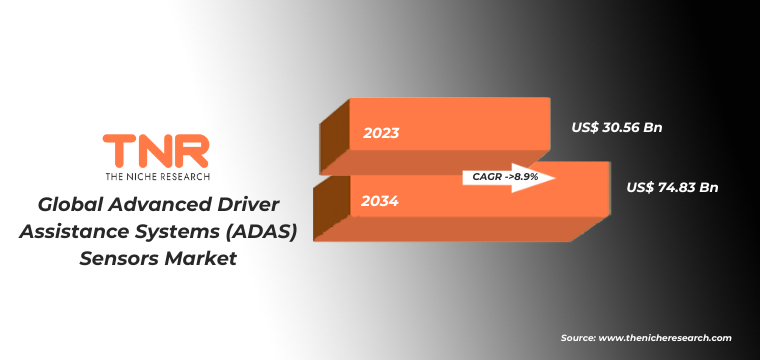
Market Segmentation: Global Advanced Driver Assistance Systems (ADAS) Sensors Market
Camera sensors are set to experience substantial growth in the global advanced driver assistance systems (ADAS) sensors market, driven by a combination of technological advancements, increasing consumer demand, and regulatory pressures. These sensors are crucial for a variety of ADAS applications, including lane departure warning, traffic sign recognition, and collision avoidance. Their growing importance is reflected in market projections, which estimate a robust compound annual growth rate (CAGR) for camera sensors over the next decade, driven by their enhanced capabilities and widespread adoption in new vehicle models.
As automotive manufacturers strive to meet consumer expectations and regulatory requirements, camera sensors are becoming integral to ADAS systems. They offer critical functionalities such as lane-keeping assist and adaptive cruise control, which improve driver safety and convenience. The shift towards higher resolution and more sophisticated imaging technologies is also driving growth. Recent innovations include high-definition cameras with 4K resolution, which provide clearer and more accurate visual data. Additionally, advancements in low-light performance and wider field-of-view capabilities are enhancing the effectiveness of camera sensors in various driving conditions.
Several key companies are driving innovation and growth in the camera sensors market. Mobileye, an Intel company, is a leading player known for its advanced driver assistance systems and camera-based technologies. Mobileye’s EyeQ technology is widely adopted by automotive manufacturers to enhance vehicle safety features. Sony Corporation is another major contributor, offering high-performance camera sensors like the Sony IMX series, which are renowned for their resolution and imaging capabilities. OmniVision Technologies also plays a critical role with its high-quality image sensors, such as the OV10635 and OV2311, designed for automotive ADAS applications. Continental AG integrates camera sensors into its ADAS solutions, supporting features such as lane-keeping assist and forward collision warning. Bosch, a prominent automotive supplier, provides a range of camera technologies that contribute to the development of advanced safety systems.
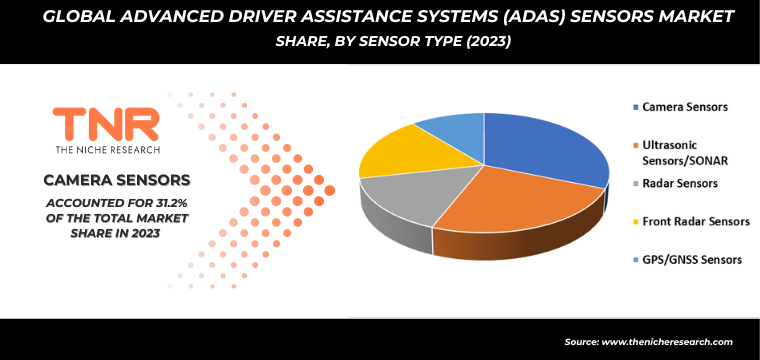
In 2023, the demand for Adaptive Cruise Control (ACC) has dominated the advanced driver assistance systems (ADAS) sensors market segment, reflecting a significant shift in consumer preferences towards enhanced driving comfort and safety. This surge in popularity is driven by several key trends, supported by robust statistical data and exemplified by market dynamics across various countries. For instance, The U.S. market has seen a substantial rise in the adoption of Adaptive Cruise Control due to high consumer demand for advanced safety features and convenience. Major automakers such as Tesla, Ford, and General Motors have incorporated ACC into their vehicle lineups, often as part of comprehensive driver assistance packages. For example, Tesla’s Autopilot system and Ford’s Co-Pilot360 include advanced ACC features that enhance vehicle safety and driving ease, reflecting their alignment with evolving consumer preferences. Similarly, Japanese automakers like Toyota and Honda are at the forefront of ACC integration, reflecting the country’s strong consumer preference for cutting-edge technology. In Japan, ACC is becoming increasingly common in new vehicle models, driven by the growing trend towards semi-autonomous driving solutions. Toyota’s Safety Sense and Honda’s Sensing technologies, which include advanced ACC features, cater to the demand for enhanced driving safety and convenience among Japanese consumers. Likewise, In Germany, the demand for Adaptive Cruise Control is driven by a combination of stringent safety regulations and high consumer expectations for advanced driving technologies. Leading German automotive manufacturers such as BMW, Mercedes-Benz, and Audi have integrated ACC as a standard or premium feature in many of their models. These manufacturers are known for their focus on high-performance and safety, which aligns with the growing adoption of ACC in the German market.

In 2023, the passenger vehicles segment dominated the advanced driver assistance systems (ADAS) sensors market, accounting for over 56% of the total market share. This significant dominance highlights the extensive integration of ADAS technologies into consumer vehicles, driven by various factors such as consumer demand, regulatory pressures, and technological advancements. The growing emphasis on vehicle safety and convenience has driven consumers to prefer vehicles equipped with advanced driver assistance systems. Features such as Adaptive Cruise Control (ACC), Automatic Emergency Braking (AEB), Lane Departure Warning (LDW), and Blind Spot Detection (BSD) are highly sought after. Regulatory bodies globally are enforcing stricter safety standards that mandate the inclusion of ADAS technologies in passenger vehicles. For example, European Union’s General Safety Regulation along with the U.S. National Highway Traffic Safety Administration (NHTSA) have implemented regulations requiring advanced safety systems to be standard in new vehicles.
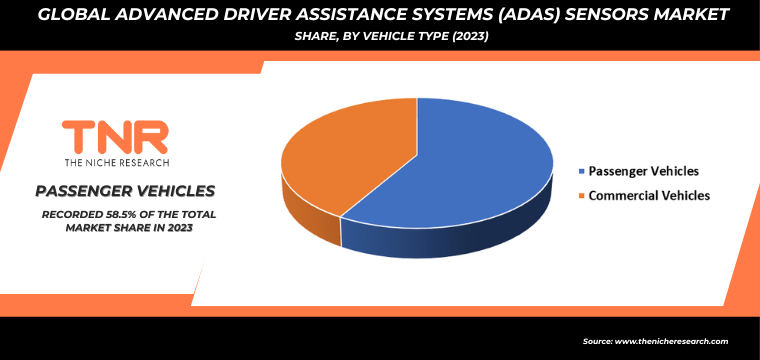
The Asia-Pacific region is poised to experience the highest growth in the advanced driver assistance systems (ADAS) sensors market, with an anticipated compound annual growth rate (CAGR) exceeding 10% during the forecast period. This remarkable growth is driven by a combination of increasing consumer demand, rapid technological advancements, and supportive government policies across several key countries in the region. China is a major driver of growth in the Asia-Pacific advanced driver assistance systems (ADAS) sensors market. The country’s large automotive market and rapid urbanization are contributing to the increased demand for advanced safety features. Chinese automakers such as BYD, Geely, and NIO are leading the way in integrating ADAS technologies into their vehicles. For example, NIO’s vehicles come equipped with advanced driver assistance systems, including high-resolution cameras and radar sensors, reflecting the company’s commitment to safety and innovation. South Korea too is experiencing significant growth in the advanced driver assistance systems (ADAS) sensors market due to the increasing adoption of advanced safety technologies by major automotive manufacturers such as Hyundai and Kia. The South Korean government is also promoting the development of smart transportation solutions, which supports the integration of ADAS features. Hyundai’s SmartSense and Kia’s Drive Wise technologies are examples of advanced ADAS systems being implemented in the region.
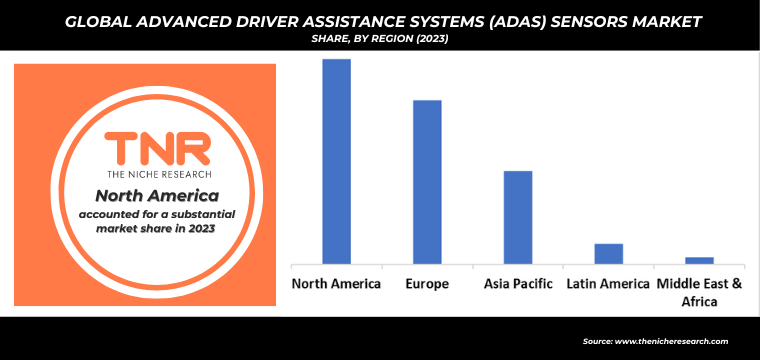
Competitive Insights: Global Advanced Driver Assistance Systems (ADAS) Sensors Market
The global advanced driver assistance systems (ADAS) sensors market is a rapidly evolving landscape, characterized by intense competition, technological innovation, and strategic alliances. This dynamic environment is driven by the increasing demand for safer, more efficient, and connected vehicles. A few of the major ADAS sensors market participants are listed below:
- Allegro MicroSystems, Inc.
- Analog Devices, Inc.
- Autoliv Inc.
- Continental AG
- CTS Corporation
- Denso Corporation
- Hella GmbH & Co. KGaA
- Infineon Technologies AG
- Microchip Technology Inc.
- NXP Semiconductors N.V.
- Panasonic Corporation
- Robert Bosch GmbH
- STMicroelectronics N.V.
- Streamax Technology Co., Ltd.
- TDK Corporation
- TE Connectivity
- Valeo S.A.
- ZF Friedrichshafen AG
- Other Market Participants
Global Advanced Driver Assistance Systems (ADAS) Sensors Market Scope:
| Report Specifications | Details |
| Market Revenue in 2023 | US$ 30.56 Bn |
| Market Size Forecast by 2034 | US$ 74.83 Bn |
| Growth Rate (CAGR) | 8.9% |
| Historic Data | 2016 – 2022 |
| Base Year for Estimation | 2023 |
| Forecast Period | 2024 – 2034 |
| Report Inclusions | Market Size & Estimates, Market Dynamics, Competitive Scenario, Trends, Growth Factors, Market Determinants, Key Investment Segmentation, Product/Service/Solutions Benchmarking |
| Segments Covered | By Sensor Type, By Application, By Vehicle Type |
| Regions Covered | North America, Europe, Asia Pacific, Middle East & Africa, Latin America |
| Countries Covered | U.S., Canada, Mexico, Rest of North America, France, The UK, Spain, Germany, Italy, Nordic Countries (Denmark, Finland, Iceland, Sweden, Norway), Benelux Union (Belgium, The Netherlands, Luxembourg), Rest of Europe, China, Japan, India, New Zealand, Australia, South Korea, Southeast Asia (Indonesia, Thailand, Malaysia, Singapore, Rest of Southeast Asia), Rest of Asia Pacific, Saudi Arabia, UAE, Egypt, Kuwait, South Africa, Rest of Middle East & Africa, Brazil, Argentina, Rest of Latin America |
| Key Players | Allegro MicroSystems, Inc., Analog Devices, Inc., Autoliv Inc., Continental AG, CTS Corporation, Denso Corporation, Hella GmbH & Co. KGaA, Infineon Technologies AG, Microchip Technology Inc., NXP Semiconductors N.V., Panasonic Corporation, Robert Bosch GmbH, STMicroelectronics N.V., Streamax Technology Co., Ltd., TDK Corporation, TE Connectivity, Valeo S.A., ZF Friedrichshafen AG, Other Market Participants |
| Customization Scope | Customization allows for the inclusion/modification of content pertaining to geographical regions, countries, and specific market segments. |
| Pricing & Procurement Options | Explore purchase options tailored to your specific research requirements |
| Contact Details | Consult With Our Expert
Japan (Toll-Free): +81 663-386-8111 South Korea (Toll-Free): +82-808- 703-126 Saudi Arabia (Toll-Free): +966 800-850-1643 United Kingdom: +44 753-710-5080 United States: +1 302-232-5106 E-mail: askanexpert@thenicheresearch.com
|
Global Advanced Driver Assistance Systems (ADAS) Sensors Market
By Sensor Type
- Camera Sensors
- Ultrasonic Sensors/SONAR
- Radar Sensors
- Front Radar Sensors
- Rear Radar Sensors
- Lidar Sensors
- GPS/GNSS Sensors
By Application
- Adaptive Cruise Control
- Glare-Free High Beam and Pixel Light
- Adaptive Light Control
- Automatic Parking
- Autonomous Valet Parking
- Navigation System
- Night Vision System
- Automatic Emergency Braking
- Crosswind Stabilization
- Driver Drowsiness Detection
- Driver Monitoring System
- Others
By Vehicle Type
- Passenger Vehicles
- Commercial Vehicles
- Heavy Commercial Vehicles
- Light Commercial Vehicles
By Region
- North America (U.S., Canada, Mexico, Rest of North America)
- Europe (France, The UK, Spain, Germany, Italy, Nordic Countries (Denmark, Finland, Iceland, Sweden, Norway), Benelux Union (Belgium, The Netherlands, Luxembourg), Rest of Europe)
- Asia Pacific (China, Japan, India, New Zealand, Australia, South Korea, Southeast Asia (Indonesia, Thailand, Malaysia, Singapore, Rest of Southeast Asia), Rest of Asia Pacific)
- Middle East & Africa (Saudi Arabia, UAE, Egypt, Kuwait, South Africa, Rest of Middle East & Africa)
- Latin America (Brazil, Argentina, Rest of Latin America)
Report Layout:
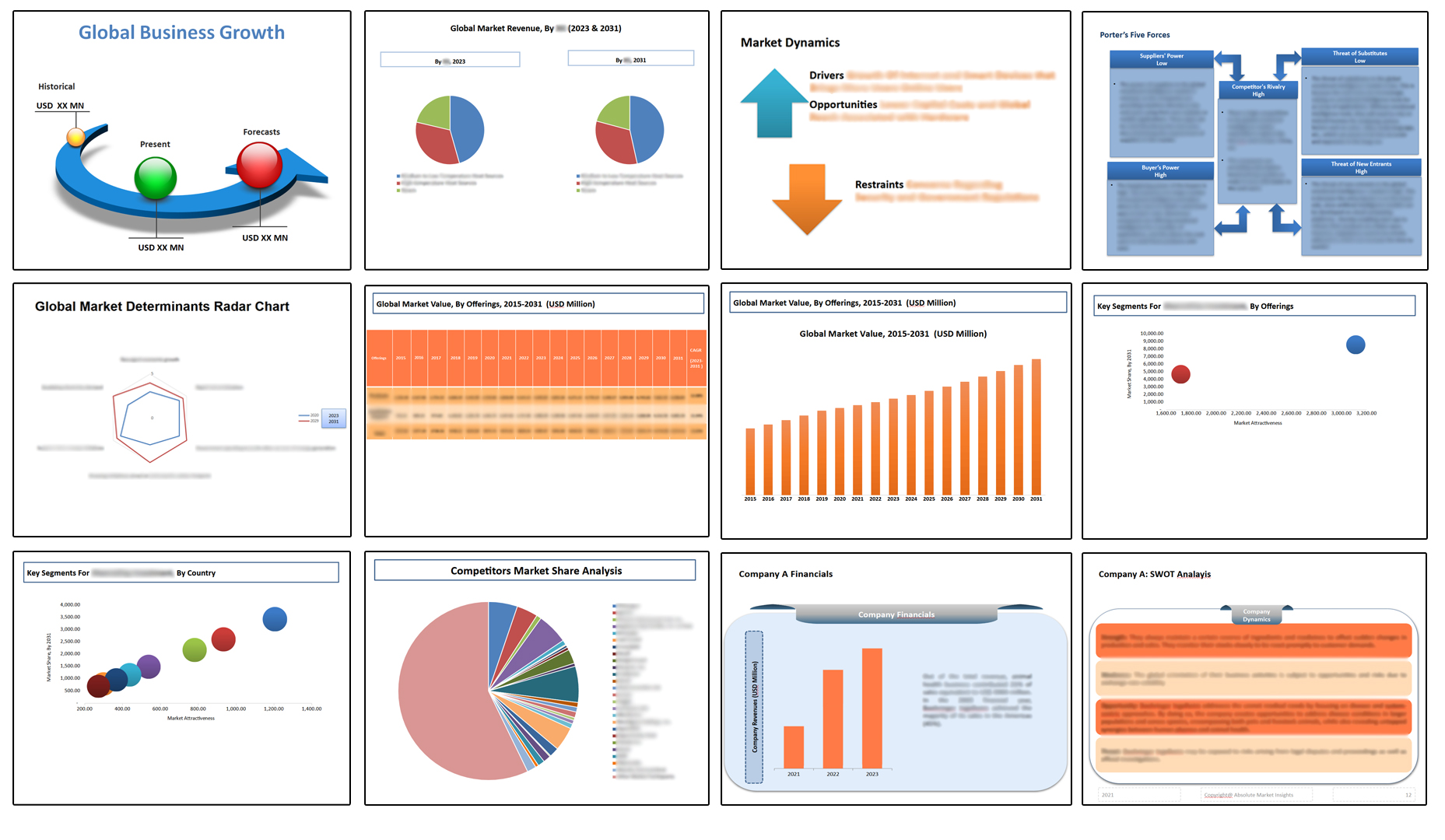
Table of Contents
Note: This ToC is tentative and can be changed according to the research study conducted during the course of report completion.
**Exclusive for Multi-User and Enterprise User.
Global Advanced Driver Assistance Systems (ADAS) Sensors Market
By Sensor Type
- Camera Sensors
- Ultrasonic Sensors/SONAR
- Radar Sensors
- Front Radar Sensors
- Rear Radar Sensors
- Lidar Sensors
- GPS/GNSS Sensors
By Application
- Adaptive Cruise Control
- Glare-Free High Beam and Pixel Light
- Adaptive Light Control
- Automatic Parking
- Autonomous Valet Parking
- Navigation System
- Night Vision System
- Automatic Emergency Braking
- Crosswind Stabilization
- Driver Drowsiness Detection
- Driver Monitoring System
- Others
By Vehicle Type
- Passenger Vehicles
- Commercial Vehicles
- Heavy Commercial Vehicles
- Light Commercial Vehicles
By Region
- North America (U.S., Canada, Mexico, Rest of North America)
- Europe (France, The UK, Spain, Germany, Italy, Nordic Countries (Denmark, Finland, Iceland, Sweden, Norway), Benelux Union (Belgium, The Netherlands, Luxembourg), Rest of Europe)
- Asia Pacific (China, Japan, India, New Zealand, Australia, South Korea, Southeast Asia (Indonesia, Thailand, Malaysia, Singapore, Rest of Southeast Asia), Rest of Asia Pacific)
- Middle East & Africa (Saudi Arabia, UAE, Egypt, Kuwait, South Africa, Rest of Middle East & Africa)
- Latin America (Brazil, Argentina, Rest of Latin America)
The Niche Research approach encompasses both primary and secondary research methods to provide comprehensive insights. While primary research is the cornerstone of our studies, we also incorporate secondary research sources such as company annual reports, premium industry databases, press releases, industry journals, and white papers.
Within our primary research, we actively engage with various industry stakeholders, conducting paid interviews and surveys. Our meticulous analysis extends to every market participant in major countries, allowing us to thoroughly examine their portfolios, calculate market shares, and segment revenues.
Our data collection primarily focuses on individual countries within our research scope, enabling us to estimate regional market sizes. Typically, we employ a bottom-up approach, meticulously tracking trends in different countries. We analyze growth drivers, constraints, technological innovations, and opportunities for each country, ultimately arriving at regional figures.Our process begins by examining the growth prospects of each country. Building upon these insights, we project growth and trends for the entire region. Finally, we utilize our proprietary model to refine estimations and forecasts.
Our data validation standards are integral to ensuring the reliability and accuracy of our research findings. Here’s a breakdown of our data validation processes and the stakeholders we engage with during our primary research:
- Supply Side Analysis: We initiate a supply side analysis by directly contacting market participants, through telephonic interviews and questionnaires containing both open-ended and close-ended questions. We gather information on their portfolios, segment revenues, developments, and growth strategies.
- Demand Side Analysis: To gain insights into adoption trends and consumer preferences, we reach out to target customers and users (non-vendors). This information forms a vital part of the qualitative analysis section of our reports, covering market dynamics, adoption trends, consumer behavior, spending patterns, and other related aspects.
- Consultant Insights: We tap into the expertise of our partner consultants from around the world to obtain their unique viewpoints and perspectives. Their insights contribute to a well-rounded understanding of the markets under investigation.
- In-House Validation: To ensure data accuracy and reliability, we conduct cross-validation of data points and information through our in-house team of consultants and utilize advanced data modeling tools for thorough verification.
The forecasts we provide are based on a comprehensive assessment of various factors, including:
- Market Trends and Past Performance (Last Five Years): We accurately analyze market trends and performance data from preceding five years to identify historical patterns and understand the market’s evolution.
- Historical Performance and Growth of Market Participants: We assess the historical performance and growth trajectories of key market participants. This analysis provides insights into the competitive landscape and individual company strategies.
- Market Determinants Impact Analysis (Next Eight Years): We conduct a rigorous analysis of the factors that are projected to influence the market over the next eight years. This includes assessing both internal and external determinants that can shape market dynamics.
- Drivers and Challenges for the Forecast Period:Identify the factors expected to drive market growth during the forecast period, as well as the challenges that the industry may face. This analysis aids in deriving an accurate growth rate projection.
- New Acquisitions, Collaborations, or Partnerships: We keep a close watch on any new acquisitions, collaborations, or partnerships within the industry. These developments can have a significant impact on market dynamics and competitiveness.
- Macro and Micro Factors Analysis:A thorough examination of both macro-level factors (e.g., economic trends, regulatory changes) and micro-level factors (e.g., technological advancements, consumer preferences) that may influence the market during the forecast period.
- End-User Sentiment Analysis: To understand the market from the end-user perspective, we conduct sentiment analysis. This involves assessing the sentiment, preferences, and feedback of the end-users, which can provide valuable insights into market trends.
- Perspective of Primary Participants: Insights gathered directly from primary research participants play a crucial role in shaping our forecasts. Their perspectives and experiences provide valuable qualitative data.
- Year-on-Year Growth Trend: We utilize a year-on-year growth trend based on historical market growth and expected future trends. This helps in formulating our growth projections, aligning them with the market’s historical performance.
Research process adopted by TNR involves multiple stages, including data collection, validation, quality checks, and presentation. It’s crucial that the data and information we provide add value to your existing market understanding and expertise. We have also established partnerships with business consulting, research, and survey organizations across regions and globally to collaborate on regional analysis and data validation, ensuring the highest level of accuracy and reliability in our reports.


